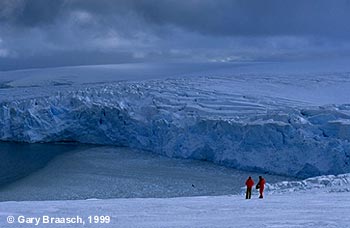The scene is breathtaking, even mystical. Four searchlight beams arrow down from above me to a vanishing point over dark water. Sea fog sweeps in along the beams and occasionally an iceberg is illuminated. From the left, a small, pale full moon is just showing over the clouds. I am on the bridge of the National Science Foundation research icebreaker Nathaniel B. Palmer, approaching the Antarctic Circle along the Antarctic Peninsula.


Our first location after crossing the Antarctic Circle is the face of Muller Ice Shelf, the most northerly shelf on the west side of the peninsula. The fjord is packed with ice. Amid the huge, tabular white icebergs — sheer ice cliffs that rise to some 70 feet tall and run hundreds of yards long — are incredible deep blue chunks of pure ice and a slurry of brash and congealing gray water. The captain carefully steers around and between the large bergs. The ship shudders as its icebreaker engines push ahead to a spot where a year before, Domack says, they took measurements in clear blue water right in front of the ice shelf. But now the shelf is still many yards ahead, and the frozen debris of disintegration prevents the ship from moving any closer.

Scientists are literally going to the ends of the earth to document the ongoing effects of climate change, taking measurements and interpreting the results. And what they are finding is profoundly troubling.
Here in Antarctica, penguins, other birds, and ocean creatures, stressed by the alterations in their surroundings, are undergoing notable behavior changes. In the South Seas, Indian Ocean, Caribbean, and elsewhere, warming and rising seas are damaging coral reefs and inundating islands. In mountain ranges everywhere, glaciers are receding, especially in the tropics and the Himalayas. Studies are documenting northward shifts in the ranges of butterflies in western North America and Europe. Birds are nesting earlier and trees are leafing out sooner in Europe, according to long-term observation records. In the boreal forest and arctic regions, temperatures are also rising rapidly, permafrost is thawing, and forests are dying in an insect assault abetted by the warmer climate. The Greenland ice cap is shrinking, as is the ice cover on the Arctic Ocean, both taken as very serious signs of instability in the northern climate.
These effects and many more are strong confirmation of climate change predictions based on a measurable worldwide rise this century in carbon dioxide, methane, and other greenhouse gases. In March of this year, scientists Ray Bradley, Michael Mann, and Malcom Hughes extended the detailed surface temperature record back to the beginning of this millennium — not only did they find that 1998 was the warmest year in the past 1,000, but also that the rise in Earth’s temperature in the 20th century reversed a 900-year cooling trend.
My project has just gotten underway, but already I can see that the picture of global warming is not the black or white “is” or “is not” argument we hear in the normal media stories. Climate is warming and changing; there is no strong scientific disagreement. However, there are many questions about the exact causes, how current trends compare with ancient climate changes, and what the results will be.

Though the 20th century temperature rise is unusual, though effects are being seen on all continents and oceans, it could still be natural, not caused by human activity, right? Sorry. A British study published in the June 10 issue of Nature lays blame on our greenhouse gas emissions more directly than any previous study. Unfortunately for those waiting for total “proof,” climate is complicated and science advances only in increments.
I believe we can’t wait for scientific proof. The Earth is speaking clearly. Climate is changing more and more rapidly. Vegetation zones are going to shift, storms are going to grow more extreme, shorelines are going to erode, diseases are going to find new habitats even as many plants and animals find theirs shrinking. No matter the extent of human culpability, there are 6 billion of us on the planet now, and we will be deeply affected by all these changes. We are going to have to adapt to them, live through them, and reduce activities that make them worse.
And if we don’t? Aboard the Nathaniel B. Palmer, my thoughts turned naturally to the Titanic, to the Ark, to Lifeboat Earth. But also, in the Antarctic night, I noticed how dark it was, just beyond the narrow beam of the searchlights.

